Brockes Passion (by Stölzel)
Brockes Passion (by Stölzel)
The Brockes-Passion can be considered the archetype of the German Passion oratorio. As such, it served as a model and source of inspiration for famous later masterpieces, enjoying uninterrupted popularity throughout the 18th century when no less than 11 composers, including Handel and Telemann, set it to music. The superb version by Reinhard Keiser fellow citizen of Brockes in Hamburg, is the first (1712). Four at that time known settings, by Keiser, Telemann, Händel and Mattheson, were performed over four evenings in 1719, 1722, 1723, and 1730.
Brockes Passion (by Stölzel)
The German poet, Barthold Heinrich Brockes, was an almost exact contemporary of J.S. Bach. He was born in Hamburg in 1680 and lived to 1747. Although we should call his specifically poetic works "minor", Brockes was an accomplished and influential figure in pre-Enlightenment Germany: he translated Alexander Pope and James Thomson's "Seasons". From a literary standpoint Brockes's most important and, indeed, voluminous work—nine sturdy volumes—is his “Irdisches Vergnugen in Gott” ( ''Earthly Contentment in God''). For many eighteenth-Century composers, however, the importance of Brockes as a writer lay in his Passion oratorio libretto, “Der fur die Sunden der Welt gemarterte und sterbende Jesus” ( ''Jesus martyred and dying for the wickedness of the world'').
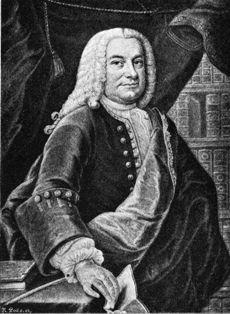
Barthold Heinrich Brockes
In Brockes' version of a passion, a tenor Evangelist narrates, in recitative passages, events from all four Gospels' accounts of Jesus' suffering and death. Persons of the Gospel story (Jesus, Peter, Pilate, etc.) have dialogue passages, also in recitative; a chorus sings passages depicting the declamation of crowds; and poetic texts, sometimes in the form of arias, sometimes that of chorales (hymn-like short choral pieces), reflect on the events. Some of the arias are for the persons of the Passion, Jesus himself, Peter, etc., but Mary the mother of Jesus, who does not appear in the Gospel accounts of the Passion, also has a singing part, and fictitious "characters", The Daughter of Zion, four solo Believing Souls, and A Chorus of Believing Souls, also observe and comment.
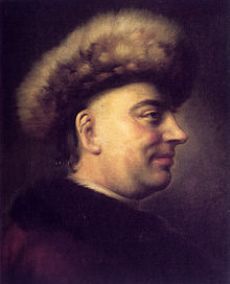
Barthold Heinrich Brockes
Gottfried Heinrich Stölzel (1690-1749) was a prolific composer of stage works, oratorios, masses, cantatas, and various instrumental works, little of his output has survived ; for example, only 12 of his 85 known secular cantatas, and fragments from only 10 of his 442 sacred cantatas, are extant. At least 18 orchestral suites and over 90 vocal serenatas are completely lost. Part of this is due to the fact that his music quickly became unfashionable after his death.
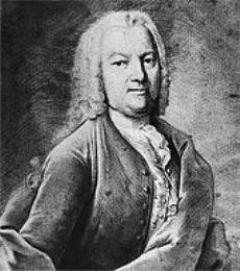
Gottfried Heinrich Stölzel
Although highly regarded prior to the Neapolitan conquest of north European opera, in modern times Stölzel was known until quite recently from a handful of works, primarily the aria "Bist du bei mir", often mistakenly attributed to J.S. Bach, and a concerto for six trumpets. Regarding "Bist du bei mir", there is nothing in the few other recorded works by Stölzel.
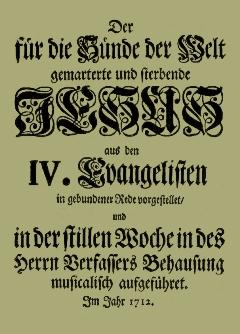
Brockes-Passion, 1712
That the Brockes-Passion was able to survive is something that we owe to a fortunate series of circumstances. Stölzel sent a copy of the passion to Sonderhausen, presumably in 1735. After several performances at the court there (such as is indicated by the parts, some of which have come down to us in multiple copies), it was stored away with numerous other compositions by him in a container. The container ended up behind the organ, and soon nobody remembered that it was there. It was not until 1870 that the court organist Heinrich Frankenberger and the later Bach biographer Philipp Spitta rediscovered it. Another hundred years would go by before a musicologist would take a closer look at Stölzel. Fritz Hennenberg's dissertation of 1965 includes a catalogue of Stölzel's cantatas and makes some remarks about the passion.
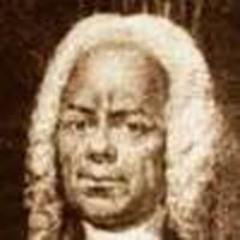
Gottfried Heinrich Stölzel
In 1996 Ludger Rémy undertook a closer examination of the sources and did some research into the background of the Gotha passion performances. After some 250 years the passion was performed again for the first time in 1997.
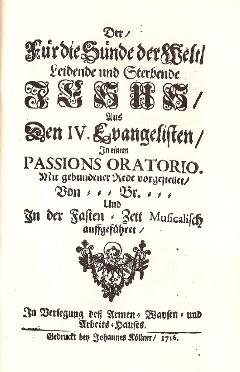
Brockes-Passion, 1716
In the personal foreword to his recording of Stölzel's Brockes-Passion (CPO, 1998), Ludger Rémy writes: "When I read the first pages of the score manuscript from Sondershausen, I was overcome by all sorts of emotions and felt no little shock. Here was a work that had been lying dormant for over 250 years, and it had an inner strength and power to it that have continued to hold me under their spell ever since then. Incredible music...and after reading it I was a changed man.
Ever since then I hove regarded the Brockes Passion by Gottfried Heinrich Stölzel as one of the most moving and genuinely human pieces of music that I have ever performed or had the good fortune to hear, and I reckon Stölzel among the truly great masters of the Central German Baroque, one who is perhaps even superior to most other composers of those times in his effect on heart and soul. I believe that the helpless silence and perplexity of humanity in face of the unchangingness of existence has only rarely found such eloquent expression in music."

Ludger Rémy
The conductor Ludger Rémy uses a first-rate period-instrument small ensemble, good chamber choir and a superb roster of vocal soloists; some of them are familiar from recordings of Bach's vocal works. Among them are soprano Dorothee Mields, with angelic voice and dramatic expression, the earthier and no-less impressive soprano Constanze Backes, the native-sounding strong-voiced counter-tenor Henning Voss, the tenors Knut Schoch (who sang the lion's share of tenor parts in Leusink's Bach cantata cycle) as the Evangelist, and Andreas Post in most of the arias, and the dignified, authoritative and reliable as ever Klaus Mertens (who sang all the bass parts in Koopman's Bach cantata cycle) as Jesus.
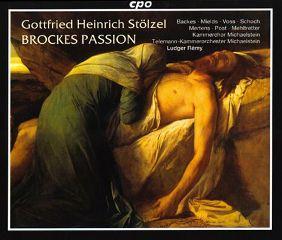
Stölzel - Brockes-Passion, album
There is the only one recording of Stölzel's Brockes-Passion. Why has not any other conductor took upon himself recording this work since 1997 ?
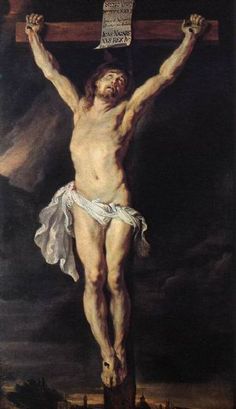
Rubens - The Crucified Christ








